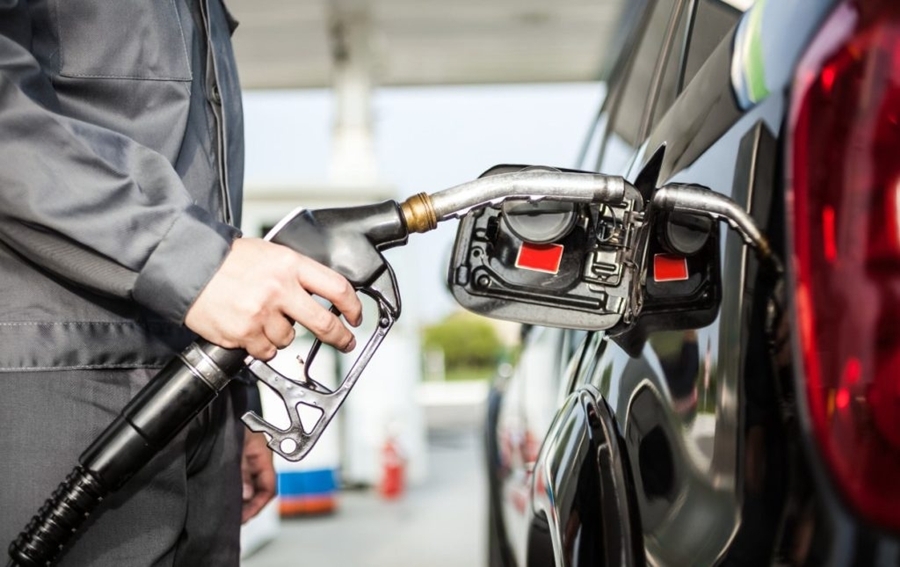If you’ve been searching for how to get better gas mileage, you’re in good company. With fuel prices constantly on the rise and environmental concerns on everyone’s mind, improving your car’s fuel economy is more important than ever. Whether you’re driving a rugged pickup or a zippy compact car, small adjustments in maintenance and driving habits can make a big difference at the pump.
In this guide, I’m sharing 13 tried-and-true strategies to help you maximize every gallon—without making your ride any less enjoyable. From personal experiences to practical tips, this is everything I’ve learned about boosting miles per gallon the smart way.
Considering buying another, more fuel efficient vehicle? Use the Fuel Cost Comparison Calculator to see if it’s worth it.
Fuel Cost Comparison Calculator
Understanding the Basics of Gas Mileage
Before diving into specific advice, it helps to understand what actually affects gas mileage. Your vehicle’s weight, shape, engine condition, and even how you drive all play a role. A heavier vehicle naturally burns more fuel, while poor aerodynamics can increase drag and waste energy. Likewise, neglecting engine maintenance or driving aggressively can quickly eat away at your fuel savings.
When I upgraded to a Ford F-150, I was shocked at how often I was refueling. That truck was a gas-guzzler compared to my old sedan, and it got me curious about how to get better gas mileage—especially without giving up the utility I loved. Turns out, the changes I made worked on both trucks and compact cars. So let’s break them down.
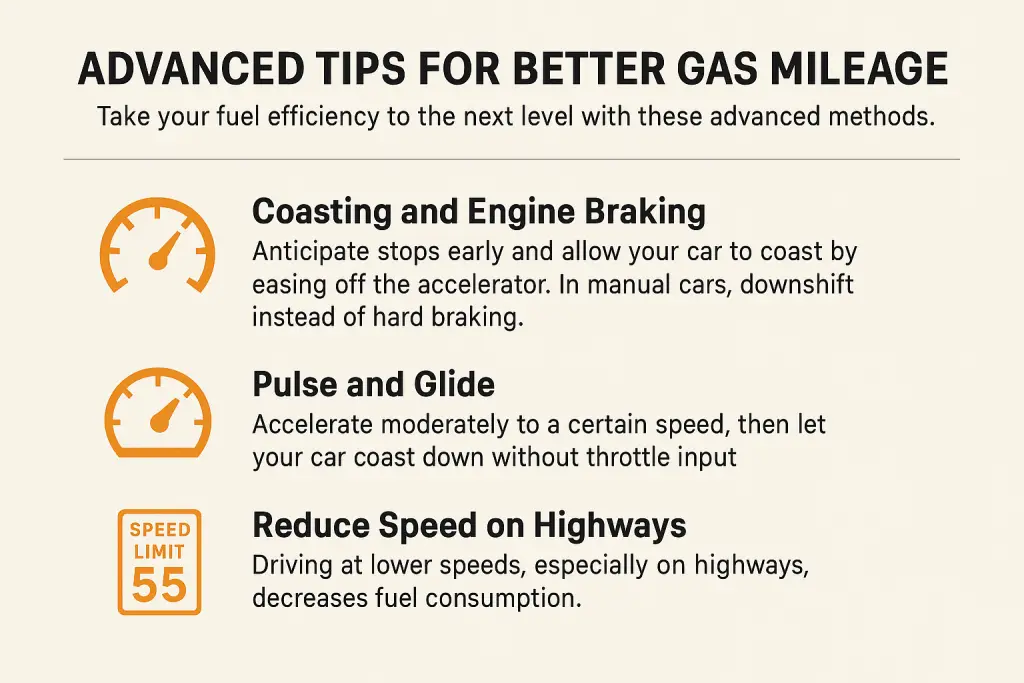
1. Keep Your Engine in Peak Condition
Regular engine maintenance is absolutely essential if you’re serious about learning how to get better gas mileage. A poorly tuned engine works harder than it should, which leads to wasted gas. Fixing something as specific as a malfunctioning oxygen sensor can improve your mileage by up to 40%. I found this out firsthand when I finally replaced the old O2 sensor in my truck. Almost immediately, I noticed I didn’t need to fill up as often. That alone made a huge difference over time.
Other maintenance tasks like routine oil changes and replacing clogged air filters can improve engine performance as well. Spark plugs, while often overlooked, can also be a culprit—if they’re worn out, your vehicle won’t burn fuel efficiently, costing you money every time you drive. If you’re looking for how to get better gas mileage without buying a new vehicle, this is one of the most impactful steps.
Also read: How Long Can Spark Plugs Last? 3 Proven Lifespan Ranges Based on Material Type (Copper vs Platinum vs Iridium)
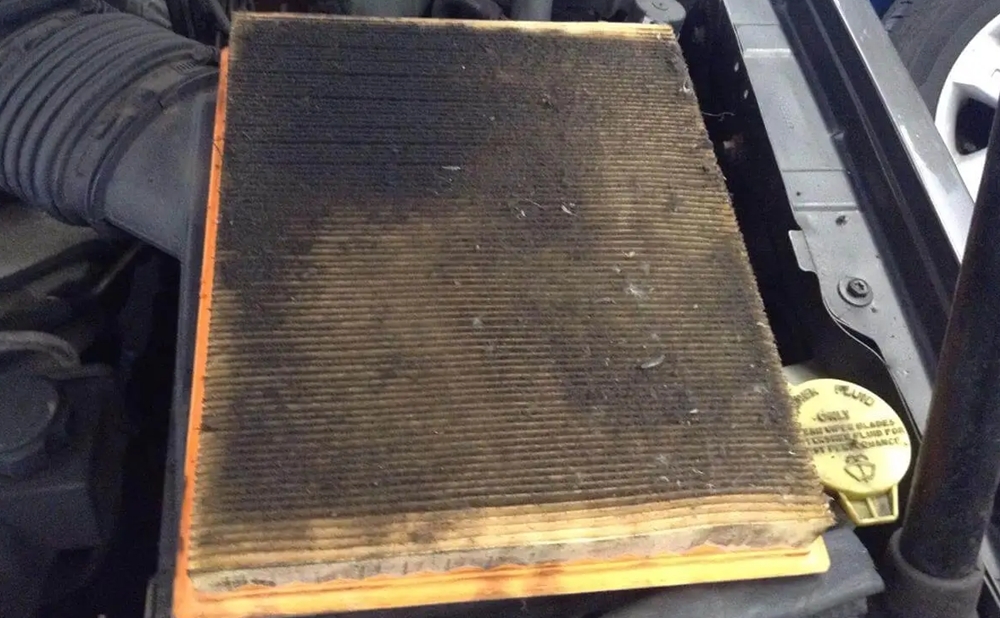
Also read: How Often To Change Car Air Filter? Schedules and Warning Signs
2. Check and Maintain Tire Pressure
This is one of the simplest things you can do to get better gas mileage, yet many drivers forget about it. Underinflated tires increase rolling resistance, making your engine work harder than necessary. I started checking my tire pressure every time I filled up at the gas station—and the results were noticeable. It’s a quick task that can improve mileage by up to 3%. If you’re wondering how to get better gas mileage without spending much, start here.
Just remember, the tire pressure listed on your tire’s sidewall isn’t the number you should follow. Look inside your driver’s side door or check your owner’s manual for the recommended PSI. Relying on the “eyeball test” alone isn’t enough. Invest in a good quality tire gauge and make it part of your monthly routine if you care about how to get better gas mileage.
3. Accelerate Smoothly and Steadily
Driving style plays a huge role in fuel consumption. Aggressive driving habits like slamming on the gas or constantly hitting the brakes can lower your gas mileage by up to 40% in city traffic. When I became more mindful of how I was accelerating—especially in traffic or at red lights—I saw a real difference in how long a tank lasted.
Gradual acceleration and coasting to a stop instead of braking hard not only saves gas but also makes for a smoother ride. On longer trips, using cruise control helps maintain a steady speed, which is more efficient than constantly speeding up and slowing down. Mastering how to get better gas mileage starts with adopting smarter habits behind the wheel.
4. Cut Down on Idling
If you’re the type to leave your car running while waiting in a parking lot or warming it up for long periods, you’re burning fuel without going anywhere. Excessive idling uses about a quarter to half a gallon of fuel per hour depending on your engine size—and gives you exactly zero miles per gallon.
I used to think letting the car warm up for 10 minutes on cold mornings was necessary, especially growing up in Minnesota. But with today’s modern engines, 30 seconds is usually enough. Cutting back on idle time is a fast and effective way to improve your fuel economy, especially during the winter months. If you’re wondering how to get better gas mileage during cold seasons, this is a critical habit to change.
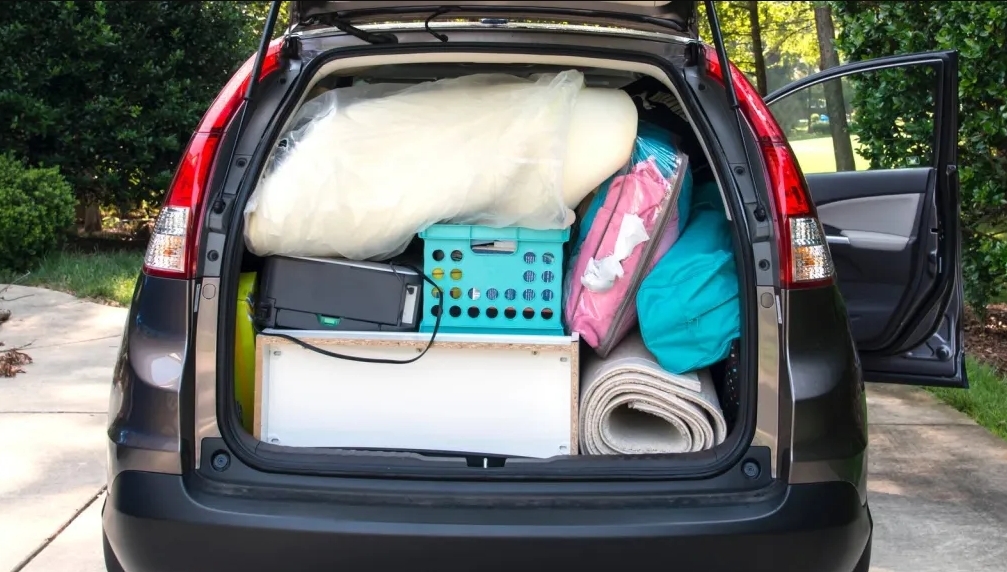
5. Lighten Your Load
Your car isn’t a storage unit. The more weight you carry, the more fuel your vehicle burns. You can actually improve gas mileage by about 1% for every 100 pounds of excess weight you remove. I was guilty of treating my truck bed like a mobile garage—tools, sports gear, random junk. Once I cleaned it out, my MPG numbers improved. For anyone researching how to get better gas mileage, this is an easy win.
This tip is even more relevant if you drive a smaller vehicle, where extra weight has an even greater impact on efficiency.
6. Avoid Overloading and Distribute Cargo Wisely
For those wondering how to get better gas mileage in a truck, this tip is crucial. Heavy loads are sometimes unavoidable, but how you pack them matters. Keep cargo balanced and secure, and avoid hauling more than you really need. Also, if you’re just driving across town, consider whether you actually need a full tank of gas. Every gallon adds weight.
7. Install a Tonneau Cover
Truck owners can make a big dent in drag by installing a tonneau cover. I added a soft roll-up one to my F-150 and immediately saw better highway mileage—around a 7% improvement. These covers reduce turbulence in the truck bed and help the vehicle move more smoothly through the air. If you’re seeking how to get better gas mileage for highway driving, this simple mod pays off.
8. Keep the Tailgate Up
This might go against popular belief, but for most pickups, driving with the tailgate up is actually more aerodynamic. Air flows more efficiently over a closed tailgate, improving fuel economy. When the gate is down, airflow becomes more chaotic and creates drag. It’s a lesser-known trick for how to get better gas mileage.
9. Add Front Air Dams
Installing a front air dam can help guide airflow around your vehicle rather than underneath it, which cuts down on resistance. It’s a relatively simple modification that makes a notable difference, especially if you do a lot of highway driving and are interested in how to get better gas mileage without major changes.
10. Ditch Roof Accessories When Not in Use
Roof racks, cargo carriers, and bike mounts can reduce fuel efficiency by as much as 25% at highway speeds. If you’re not actively using them, take them off. Removing unnecessary roof gear reduces drag and helps your vehicle slice through the air more efficiently. It’s one of the easiest steps you can take toward how to get better gas mileage with almost no effort.
11. Keep Windows Closed on the Highway
While it might feel refreshing to drive with the windows down, doing so at high speeds increases aerodynamic drag. On the highway, it’s better to keep windows closed and use air conditioning sparingly. Contrary to what some think, light A/C use can sometimes be more efficient than open windows when traveling fast. This is another example of how to get better gas mileage through small driving behavior changes.
12. Repair Dents and Misaligned Panels
It may not seem like body damage could impact fuel economy, but dents, dings, and misaligned panels disrupt airflow and increase drag. If you’re serious about maximizing miles per gallon, keeping your vehicle’s exterior in good shape can help. It’s a surprisingly helpful strategy when exploring how to get better gas mileage.
13. Use Technology to Track and Improve MPG
Thanks to modern tech, learning how to get better gas mileage has never been easier. I started using an app called Fuelly to track my fill-ups and driving habits. It helped me identify which routes were more efficient, even if they were slightly longer in distance. Some GPS systems also offer eco-friendly routing that prioritizes fuel-saving roads over the shortest distance.
Improving your vehicle’s fuel economy doesn’t have to be complicated. With just a few simple changes—keeping your tires inflated, driving a little more smoothly, and cleaning out the trunk—you can stretch every tank a little further. Whether you’re trying to save money, help the environment, or just make fewer trips to the gas station, knowing how to get better gas mileage is a win all around.
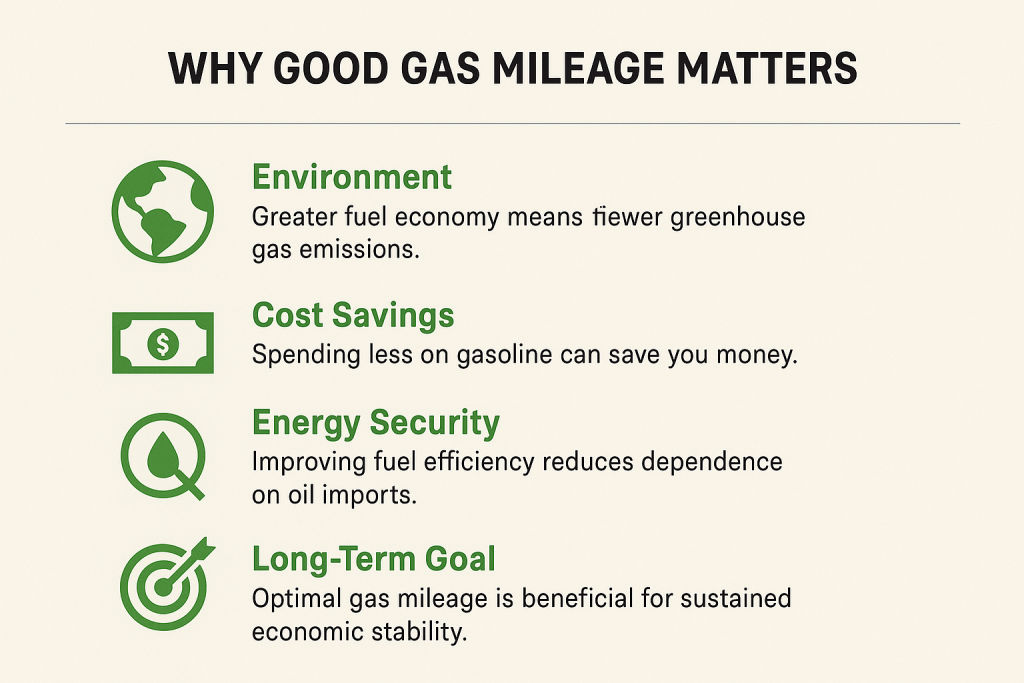
Fuel and Additive Considerations: What You Use Matters
If you’re serious about learning how to get better gas mileage, it’s time to look beyond driving habits and under the hood—literally. The fuel you put in your tank and the additives you use (or don’t use) can significantly impact your car’s performance and fuel economy.
Use the Recommended Fuel Grade
Let’s start with something that often trips people up: fuel grade. Contrary to popular belief, choosing premium gas doesn’t automatically mean your car will run better. In fact, unless your owner’s manual explicitly calls for high-octane fuel, you’re better off sticking with regular. Using premium fuel in an engine that’s designed for regular won’t improve performance or efficiency—it just drains your wallet.
Some cars, especially performance vehicles or certain flex-fuel models, are built with specific fuel types in mind. If your car is rated for E85 or another alternative fuel, using the recommended option can help maintain the engine’s intended performance and efficiency. Otherwise, stick with what’s specified for your model.
Be Smart About Fuel Additives
Now, let’s talk fuel additives. The shelves at auto parts stores are packed with bottles promising miracle fuel savings, but the truth is far less exciting. Most aftermarket fuel additives show little to no improvement in controlled tests. It’s easy to get lured in by bold marketing claims, but I’ve found it’s best to be skeptical unless the additive is recommended by your vehicle’s manufacturer.
Every now and then, using a fuel system cleaner—especially one that’s OEM-approved—can help keep things running smoothly, but don’t expect it to transform your MPG overnight. It’s a tool for long-term engine health, not a quick fix for poor fuel mileage.
The Bottom Line on Fuel Choices
The takeaway? If you’re focused on how to get better fuel mileage, the best results usually come from smart fuel choices and solid maintenance—not a $10 bottle promising magic in a tank. Know what your engine is built for, stick to the recommended fuel type, and only use additives when they truly add value.
How to Improve MPG in Extreme Weather
Weather doesn’t just affect your wardrobe—it can drastically affect your gas mileage, too. Whether you’re bundling up in the winter or cranking the A/C during summer, those temperature extremes take a toll on your fuel economy. Here’s how to beat the elements and keep your mileage in check.
Cold Weather Fuel-Saving Tactics
Living in the Midwest, I’ve experienced firsthand how brutally cold mornings can sabotage your MPG. Engines take longer to warm up, oil thickens, and you’re more tempted to idle just to get the cabin warm. But here’s the truth: long idling doesn’t do your gas tank any favors.
Instead, try parking in a garage or a warmer spot whenever possible. Your car warms up faster, and you won’t have to run the heater as long. Block heaters are another great investment if you’re dealing with seriously cold temperatures—they pre-warm the engine and cut down on fuel-wasting idle time.
One of my favorite winter tricks? I combine errands into a single outing. When your engine is already warm, it runs more efficiently, so you avoid the fuel penalty that comes from multiple cold starts. I’ve tracked my own numbers and found that this one habit alone saves me up to 20% in fuel during the colder months.
Hot Weather Efficiency Tips
On the flip side, when summer hits and temperatures soar, A/C use becomes the big fuel drain. I’ve found that parking in the shade or using a reflective windshield shade helps keep the interior cooler, so I’m less reliant on blasting the A/C as soon as I hop in. At slower speeds—say under 35 mph—driving with the windows down can be more efficient than running the air conditioner. But at highway speeds, rolled-down windows increase drag, so it’s actually better to use A/C in moderation instead.
Managing how you respond to weather is a practical part of figuring out how to get better gas mileage year-round. It’s not just about what you drive—it’s how you adapt to conditions.
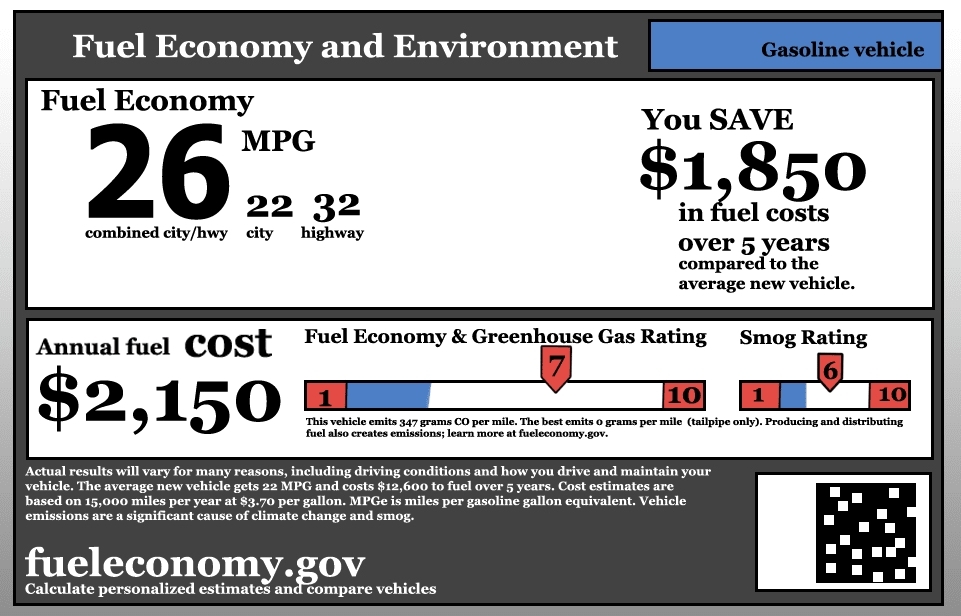
Long-Term Strategies for Better Gas Mileage
Some changes take time but are well worth considering if you’re serious about improving fuel efficiency in the long haul. Let’s look at two big-picture strategies that have helped me and plenty of others cut back on fuel costs.
Choose the Right Vehicle—or Modify the One You Have
Not everyone is in the market for a new ride, but if you are, take the time to compare EPA fuel economy ratings before buying. Consider your actual needs—do you really need a full-size truck every day, or could a smaller vehicle serve you just as well for 90% of your driving?
When I switched from an oversized SUV to a mid-size crossover, my fuel economy jumped by nearly 30%. If switching vehicles isn’t in the cards, consider smart modifications for your current ride. Pickup owners, for example, can look into things like aerodynamic upgrades, low-rolling-resistance tires, or even a more efficient exhaust system. These changes won’t turn a truck into a Prius, but they can make a noticeable dent in fuel consumption.
Route Smarter, Not Harder
This one is often overlooked but incredibly effective. Optimizing your routes can yield real savings without costing a cent. I started using Google Maps not just for directions, but to plan errand runs during low-traffic times. By combining multiple stops into one loop—rather than zigzagging all over town—I cut down significantly on idle time and unnecessary mileage.
In fact, this habit alone has saved me about 15% on my weekly fuel use. It’s the kind of strategy that pays dividends quietly, week after week. If you’re trying to learn how to get better gas mileage, efficient trip planning is low-effort and high-reward.
Advanced Driving Tips: Hyper-Mileage Habits for Real Results
Once you’ve nailed the basics of maintenance and smooth driving, it’s time to level up your strategy. These advanced techniques are ideal for anyone serious about learning how to get better gas mileage in everyday driving or long road trips.
Master Coasting and Engine Braking
Rather than riding the accelerator until the last second, anticipate stops early and let your car coast naturally. In manual cars, downshifting (aka engine braking) instead of hard braking saves both fuel and your brake pads. Even in automatics, easing off the throttle early helps conserve momentum and improves MPG.
Try Pulse and Glide
A favorite among hypermilers, pulse and glide involves accelerating moderately up to a certain speed, then letting your car coast down without throttle input. It’s not ideal for heavy traffic, but on open roads, it can noticeably improve gas mileage—especially in hybrids or fuel-efficient models.
Reduce Speed on Highways
Speed matters. Driving at 75 mph instead of 65 mph can reduce fuel economy by 10–15%. Sticking to moderate speeds not only boosts safety but also shows you how to get better gas mileage without modifying your car.
Tech Tips That Boost Fuel Efficiency
Modern vehicles and gadgets give us better control over our fuel use than ever before. If you’re wondering how to get better gas mileage without changing your lifestyle, these tech solutions make it easier to track and improve efficiency in real time.
Use a Real-Time MPG Monitor
Devices like the ScanGauge or a Bluetooth-enabled OBD-II adapter (like FIXD or BlueDriver) plug into your car’s diagnostic port and show live fuel economy data. Seeing how different habits impact MPG instantly helps you adapt for better results.
Take Advantage of Eco Mode
If your vehicle has an Eco Mode, use it! This feature adjusts throttle sensitivity, shift points, and even A/C performance to help you drive more efficiently. You might not feel the same acceleration punch, but your gas mileage will thank you.
Try Fuel Efficiency Apps
Apps like Fuelly, Drivvo, and Simply Auto track your fill-ups, MPG, and maintenance reminders. Some even calculate your cost per mile or let you compare performance across vehicles.
Fuel Efficiency Tech Comparison Table
| Tool Type | Best For | Estimated MPG Gain | Ease of Use |
|---|---|---|---|
| OBD-II Monitors | Real-time feedback & diagnostics | 5–15% | Moderate |
| Eco Mode | Simple fuel saving with no setup | 3–7% | Very easy |
| Fuel Apps | Tracking trends and habits | Awareness-based | Very easy |
By integrating a few of these tools into your routine, you’ll quickly see how to get better gas mileage without sacrificing convenience or comfort.
Environmental and Long-Term Mindset: The Bigger Picture
While saving money is usually the main motivation, there’s a bigger reason to focus on how to get better gas mileage—our planet.
Fuel Efficiency Reduces Carbon Emissions
The less fuel you burn, the fewer emissions your vehicle produces. This helps reduce greenhouse gases and local air pollution. Even a 10% improvement in fuel efficiency can keep hundreds of pounds of CO₂ out of the atmosphere each year.
Set and Track Your MPG Goals
Instead of aiming for vague improvement, set measurable goals. Maybe you want to increase your average MPG from 22 to 26. Use an app or notebook to track your progress. Seeing improvement reinforces good habits and keeps you motivated.
Consider Future Vehicle Choices
If you’re in the market for a new ride, fuel economy should be high on your checklist. Even small cars today often outpace trucks and SUVs in terms of MPG—and over five years, the savings can be massive. Ask yourself: Do I need a large vehicle every day, or would a smaller car or hybrid work better most of the time?
Need a mechanic? Find one on the Mobile Mechanic Directory
FAQ: How to Get Better Gas Mileage — Quick Answers to Common Questions
What’s the fastest way to get better gas mileage?
The quickest way to improve gas mileage is to check and maintain proper tire pressure, avoid aggressive acceleration, and remove excess weight from your vehicle. These changes may seem small, but they’re foundational for anyone learning how to get better gas mileage right away.
Does driving slower really help with how to get better gas mileage?
Yes, absolutely. Speeds over 60 mph reduce fuel efficiency significantly. By keeping your speed consistent and within the optimal range, you’ll discover firsthand how to get better gas mileage on the highway.
Will premium fuel help me get better MPG?
Not unless your vehicle specifically requires it. Using premium fuel in an engine built for regular gas won’t improve efficiency. When researching how to get better gas mileage, always follow your manufacturer’s fuel recommendations.
Can using cruise control improve gas mileage?
Definitely. Cruise control helps maintain a steady speed, which reduces unnecessary acceleration and braking—two major fuel-wasters. It’s one of the simplest tech-based answers to how to get better gas mileage during long trips.
How does cold weather affect how to get better gas mileage?
Cold temperatures lower engine efficiency and increase fuel consumption due to longer warm-up times and thicker motor oil. If you live in a colder region and want to learn how to get better gas mileage, try combining trips, using a garage, and limiting idle time.
Is there a difference in how to get better gas mileage between trucks and small cars?
Yes. Trucks face additional aerodynamic drag and weight, so techniques like installing a tonneau cover, reducing cargo load, and managing RPMs are especially effective. While the core tips apply to all vehicles, how to get better gas mileage in a truck requires extra attention to aerodynamics and load distribution.
Final Thought: Consistency Is What Counts
There’s no single silver bullet when it comes to boosting fuel economy—but small, smart choices really add up. The secret to how to get better gas mileage lies in consistency. Whether it’s keeping your tires properly inflated, changing your driving habits, or parking strategically during temperature extremes, every bit helps.
Some of these tactics might only save you 1-2% individually. But stack enough of them together, and you could improve your MPG by 20–30% or more. That’s not just good for your budget—it’s also good for the planet.
So whether you’re hauling gear in a heavy-duty truck or commuting in a nimble hatchback, the same fuel-saving principles apply. Maintain your vehicle, drive mindfully, adapt to weather, and plan your trips with intention. Start small, stay consistent, and let the savings roll in.
Your car—and your wallet—will thank you.


